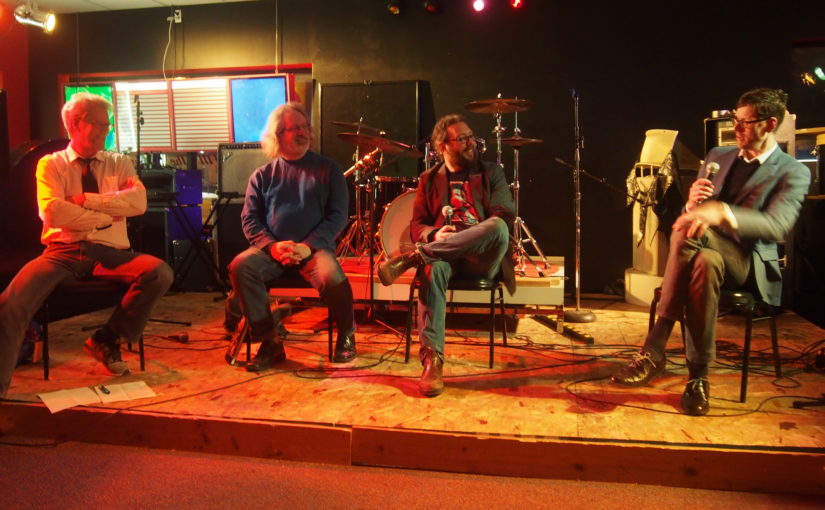LAURA ELLEN BRANDJORD | Photo Courtesy
Agonizing over whether or not President Donald Trump is an embodiment of punk rock is probably a quandary few have found themselves in. Yet it was the subject that a panel addressed at the book release party held at Ojata Records and Comics in Grand Forks on the evening of Jan. 20. The panelists ranged in occupation from a city official to a Mediterranean anthropologist, but all shared a love for punk rock music.
Moderator and city council member Bret Weber started off the discussion by briefly listing the tenants of punk as “possess a do-it-yourself ethic, make your own music, a passion that leads to frank openness, willingness to endure alienation and ridicule and engaging in career paths ‘less traveled.'” Weber referred to these traits as the “happy side of punk” before going on to describe punk music’s dark side of misogyny, racism and violence.
Here is where we start the journey down the rabbit hole.
Weber called attention to the fact that Trump seems to embody many of the traits from the “happy side.” It can’t be denied that Trump marches to the beat of his own drummer and seems unaffected by any backlash or ridicule for his comments (Twitter or otherwise). The President’s platform ran on being outspoken and frank about his views, which drew many supporters.
Herein lie the all-important questions of the evening: “Is Trump the new punk? And what does this mean for punk and punks?”
Author and UND professor Chris Gable started off the conversation by drawing on the similarities between Trump’s behaviors and those of the Sex Pistols when they were starting to “make it big.” Fellow UND professor and author of “Lusty Scripts” Brian Schill added, “Both the Sex Pistols and Trump are destructive. But, if Trump is punk, then punk is done for. I mean it’s in the White House. It has finally won. It doesn’t need to exist anymore.”
Anthropologist Bill Caraher pointed out that punk extends the same opportunity to Trump and the alt-right to voice their concerns as it gives the resistance a platform. He added that punk is as culpable for the current state of affairs as the hippies were in the ’60s and ’70s. However, he remained optimistic that the fact that four middle-aged white punks acknowledge their role in the mess we are currently in is a good sign for positive change.
Gable gave an insight that spurred a discussion on what punk meant to the panelists when he said, “In Brexit and the election of Trump we saw an act of generative destruction coupled with self-preservation. I think that much of the blue collar working class that felt the system was no longer working for them, without necessarily intending for it to happen, voted for these things with the intention of self-preservation. I don’t think they necessarily wanted Trump to be president or to leave Brexit, but voted for these things with the hope that it would make things better for them because the way things currently were wasn’t working.”
An interesting paradox began to form as the panelists validated the idea that punk is self-preservative as well as self-destructive.
Schill argued punk is self-destructive in order to show society what it is doing to them. “In our era of economic distress which has made us all subjects to capitalism, I’m going to embody this by rolling around in broken glass and cutting myself like Iggy used to do to show the ‘master’ or whoever what they have done and continue to do to me, to us.”
Gable on the other hand believed punk to be a hopeful form of destruction. He suggested punk was destructive with the goal of allowing something beautiful to grow from the ashes. They may not have any idea what to do after the destruction, but they set the stage for the possibility of something better to come along.
Caraher ended by saying that in a Venn diagram of punk and Trump, the overlap is substantial, “I’d say the overlap is 30, 50 percent. Why not? But I think that is a reason for optimism instead of despair because it proves that we aren’t as different as we are appear or sometimes think.” There is the opportunity for progress and common ground to be found because of this overlap.
After a brief question and answer interaction with those in attendance, there was just enough time to grab a hot dog or poutine from the record/comic store’s very own “Dogmahal” concession stand before the entertainment began.
First up was indie artist June Panic, who was originally planning on playing with accompaniment from a rock band. Due to a last minute conflict, however, the seasoned performer gave a thought-provoking set of new acoustic songs.
The final band of the night was punk rock band Mistaken Thieves. Comprised of UND college students and Grand Forks natives Lucas Campoverde (vocals/guitar), Andy Mankse (drums) and Francis Austin (bass). After addressing a malfunctioned bass drum pedal halfway through their opening cover of Kaleo’s “No Good,” the band continued with a mix of original songs and a medley of Cage the Elephant’s “One Ear” and “Ain’t No Rest For the Wicked.”
Something about this event was truly satisfying. Was it the unique venue, the engaging panel discussion, the music or the people themselves? I honestly can’t put my finger exactly on it. I do know one thing for sure, I hope to attend more events such as this in the future.
